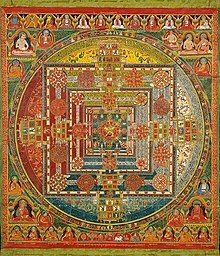
Back Калачакра Bulgarian কালচক্র Bengali/Bangla དུས་འཁོར། Tibetan Kálačakra Czech Kalachakra German Kalachakra Spanish Kālatšakra Estonian Kalachakra French कालचक्र Hindi Kálacsakra Hungarian

Kālacakra (Tibetan: དུས་ཀྱི་འཁོར་ལོ།, Wylie: dus kyi 'khor lo) is a polysemic term in Vajrayana Buddhism as well as Hinduism that means "wheel of time" or "time cycles".[1] "Kālacakra" is also the name of a series of Buddhist texts and a major practice lineage in Indian Buddhism and Tibetan Buddhism.[2] The tantra is considered to belong to the unexcelled yoga (anuttara-yoga) class.[3]
Kālacakra also refers both to a patron tantric deity or yidam in Vajrayana and to the philosophies and yogas of the Kālacakra tradition. The tradition's origins are in India and its most active later history and presence has been in Tibet.[2] The tradition contains teachings on cosmology, theology, philosophy, sociology, soteriology, myth, prophecy, medicine and yoga. It depicts a mythic reality whereby cosmic and socio-historical events correspond to processes in the bodies of individuals. These teachings are meant to lead to a transformation of one's body and mind into perfect Buddhahood through various yogic methods.[2][4]
The Kālacakra tradition is based on Mahayana Buddhist non-dualism, which is strongly influenced by Madhyamaka philosophy, but also draws on a wide range of Buddhist and non-Buddhist (mainly Hindu) traditions (such as Vaibhāṣika, Kashmir Shaivism, Vaishnavism, and Samkhya). The Kālacakra tradition holds that Kālacakra teachings were taught in India by Gautama Buddha himself.[5][6] According to modern Buddhist studies, the original Sanskrit texts of the Kālacakra tradition "originated during the early decades of the 11th century CE, and we know with certainty that the Śrī Kālacakra and the Vimalaprabhā commentary were completed between 1025 and 1040 CE."[7] Kālacakra remains an active tradition of Buddhist tantra in Tibetan Buddhism, particularly within the Jonang tradition, and its teachings and initiations have been offered to large public audiences, most famously by the 14th Dalai Lama, Tenzin Gyatso.
- ^ (Sanskrit: kāla, lit. 'time' + Sanskrit: cakra, lit. 'wheel')
- ^ a b c John Newman (1991). Geshe Lhundub Sopa (ed.). The Wheel of Time: Kalachakra in Context. Shambhala. pp. 51–54, 62–77. ISBN 978-1-55939-779-7.
- ^ Wallace 2001, p. 6.
- ^ Dalai Lama (2016). Jeffrey Hopkins (ed.). Kalachakra Tantra: Rite of Initiation. Wisdom Publications. pp. 13–17. ISBN 978-0-86171-886-3.
- ^ Dakpo Tashi Namgyal (2014). Mahamudra: The Moonlight: Quintessence of Mind and Meditation. Simon and Schuster. pp. 444 note 17. ISBN 978-0-86171-950-1.
- ^ Fabrice Midal (2005). Recalling Chogyam Trungpa. Shambhala Publications. pp. 457–458. ISBN 978-0-8348-2162-0.
- ^ Newman, John (1998). "The Epoch of the Kālacakra Tantra". Indo-Iranian Journal. 41 (4): 319–349. doi:10.1163/000000098124992781. ISSN 0019-7246. JSTOR 24663342. S2CID 161363549.
© MMXXIII Rich X Search. We shall prevail. All rights reserved. Rich X Search